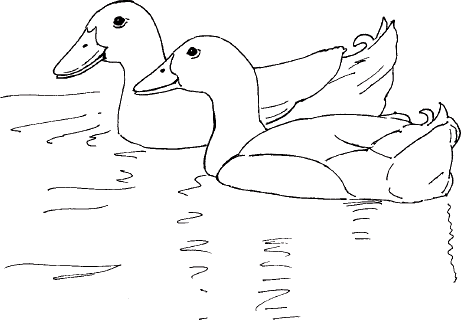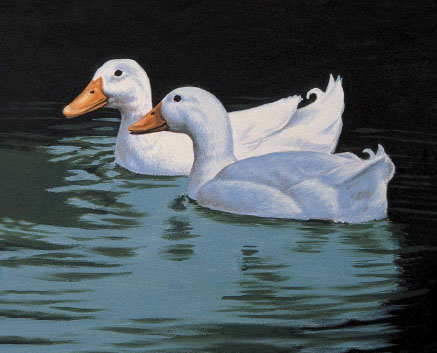Project 24: Ducks
One of my favorite places for photography and sketching is the Lexington Cemetery in Lexington, Kentucky. Founded in 1848, it is a beautiful place with large, old trees, sunken gardens, flowers and secluded ponds. Many animals live there, including chipmunks, squirrels, rabbits and birds. This is where I encountered these attractive white ducks. Graceful swimmers, they seemed to glide effortlessly across the water.


Reference Photo
Materials
Paints
Burnt Umber
Cadmium Orange
Cadmium Yellow Light
Payne’s Gray
Raw Sienna
Titanium White
Ultramarine Blue
Viridian
Yellow Oxide
Brushes
no. 1, 3, 5 and 7 rounds
no. 10 shader

1 Establish the Form and the Dark Values
Draw the ducks lightly in pencil, using your kneaded eraser for any corrections. Use Payne’s Gray thinned with water and a no. 3 round to paint the basic lines, lights and darks. Use a no. 7 round for the broader areas and for the water.
Mix the dark brown for the ducks’ eyes and bills with Burnt Umber and Ultramarine Blue. Paint with a no. 3 round.
For the dark shadowed parts of the feathered areas, mix a gray with Titanium White, Ultramarine Blue, Burnt Umber and a small amount of Raw Sienna. Paint with a no. 3 round, using parallel strokes.
I mixed the dark green for the water with Viridian, Burnt Umber, Ultramarine Blue and a small amount of Cadmium Orange. I painted with a no. 5 round with smooth, horizontal strokes. For the broad expanses of water, I switched to a no. 10 shader, painting carefully around the ducks’ outlines with a no. 5 round. When everything was dry, I added another coat.
I mixed the blue-green reflection base color for the water from Titanium White, Viridian, Ultramarine Blue and Burnt Umber. Ipainted with a no. 7 round with long, smooth, horizontal strokes.
Icreated the greenish water color from Viridian, Titanium White, Ultramarine Blue and Burnt Umber. I painted these areas with a no. 7 round, using smooth strokes that followed the ripple pattern.

2 Paint the Middle Values
For the ducks’ bills, mix an orange with Cadmium Orange, Titanium White, Yellow Oxide and a small amount of Raw Sienna. Paint with a no. 3 round. Mix a darker shadow color for the bill with the orange, Burnt Umber and more Cadmium Orange and Raw Sienna. Paint with a no. 3 round. Re-establish the line of the mouths, nostrils and darker shadows on their bills with a no. 3 round and the dark brown from Step 1.
Mix a light blue for the ducks’ shadows with Titanium White, Ultramarine Blue and small amounts of Yellow Oxide and Burnt Umber. Paint with a no. 5 round.

3 Paint the Light Values
With Titanium White and small amounts of Ultramarine Blue and Cadmium Yellow Light, mix an even lighter value blue for the highlighted parts of the forefront duck. Paint with a no. 5 round. Use a no. 3 round and the light blue from Step 2 to blend where the two colors meet, using small, parallel strokes. With a separate no. 3 round and the gray from Step 1, blend where this color meets the light blue. Begin to add some detail with the gray.
Use a no. 5 round and the light blue to add detail to the shadowed parts of the duck with light-pressured strokes.
Mix the warm white for the highlighted parts of the background duck with Titanium White and a touch of Cadmium Yellow Light. Paint the broad areas with a no. 5 round, switching to a no. 3 round for the smaller detail areas, such as the head and tail. Blend the light blue with the warm white and the gray.
Mix a highlight color for the bill of the far duck with Titanium White and touches of Cadmium Yellow Light and the orange from Step 2. For the near duck, add a little more of the orange for a darker highlight color. Paint with no. 3 rounds, blending with the adjacent color and a separate no. 3 round.
With a no. 5 round and the greenish water color from Step 1, I added ripple marks to the water with slightly curved, sweeping strokes.
Tip
For lighter value detail, mix a little of the light blue into a bit of the gray.

QUACKA BLANCA
Acrylic on Gessobord
8” × 10” (20cm × 25cm)
4 Paint the Finishing Details
Use no. 3 rounds to add more detail to the ducks’ feathers, blending with the neighboring colors. Re-establish the shapes of the eyes as needed with a no. 1 round and the dark brown color. Paint highlights in the eyes with the lightest value blue and a no. 1 round.
I continued to paint ripples in the water with the greenish color and a no. 5 round. I used the light bluish color from Step 2 and a no. 5 round to paint the ducks’ reflections with horizontal strokes.
I painted some orange reflections in the water from the ducks’ bills with the orange bill color from Step 2 and a no. 5 round.
